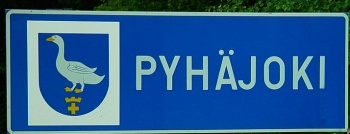Pyhäjoki: Difference between revisions
Jump to navigation
Jump to search
Knorrepoes (talk | contribs) m (Text replacement - "50 px|link=Finland[[Category" to "[[Category") |
Knorrepoes (talk | contribs) m (Text replacement - "{{media}} Literature : Pirinen, 1982" to "'''Literature''': Pirinen, 1982 {{media}}") |
||
| Line 21: | Line 21: | ||
|align="center"|[[File:pyhajoki1.jpg|center|350 px|Arms of {{PAGENAME}}]] <br/>The arms on a road sign | |align="center"|[[File:pyhajoki1.jpg|center|350 px|Arms of {{PAGENAME}}]] <br/>The arms on a road sign | ||
|} | |} | ||
'''[[Literature]]''': Pirinen, 1982 | |||
{{media}} | {{media}} | ||
[[Category:Finnish Municipalities P]] | [[Category:Finnish Municipalities P]] | ||
Revision as of 04:30, 10 September 2022
Finland heraldry portal
This page is part of the Finland heraldry portal |
Heraldry of the World |
|
Civic heraldry:
|
Other heraldry: |
PYHÄJOKI
Region : Pohjois-Pohjanmaa
Former province : until 2009 Oulu
Official blazon
Sinisessä kentässä hopeinen kultavaruksinen hanhi, jonka alapuolella kultainen kruunu ja risti alakkain.
Origin/meaning
The arms were officially granted on September 22, 1965.
The goose refers to a boulder near the mouth of the river Pyhäjoki, named Hanhikivenniemi (= goose-stone). Towards the end of 15th century the Russians considered the boulder the border. The cross and crown are the boundary marks, carved into the stone.
| The arms on a road sign |
Literature: Pirinen, 1982
Contact and Support
Partners:
Your logo here ?
Contact us
© since 1995, Heraldry of the World, Ralf Hartemink 
Index of the site













